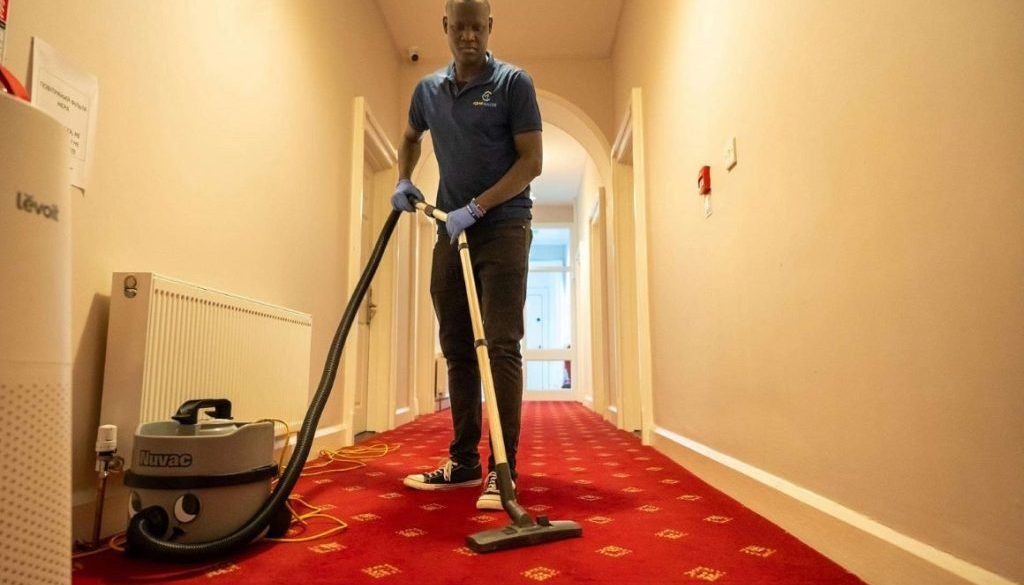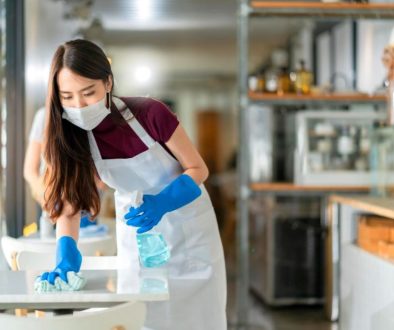The Ultimate Guide to Upholstery Cleaning: Tips, Tricks, and Expert Advice
Are you struggling to keep your upholstery clean and looking its best?
Look no further – we’ve got you covered with the ultimate guide to upholstery cleaning. Whether you have a beloved sofa, a cozy armchair, or an elegant dining chair, this comprehensive guide is packed with tips, tricks, and expert advice to help you achieve spotless and fresh-looking upholstery.

From removing stains to tackling odors, we’ll walk you through the step-by-step process of cleaning different types of upholstery materials, such as fabric, leather, and microfiber. We’ll also share tried-and-tested homemade remedies and cleaning products that will leave your furniture looking like new.
But it’s not just about cleaning – we’ll delve into tips for proper maintenance and care to extend the lifespan of your upholstery. Discover how to prevent stains, reduce wear and tear, and protect your furniture from the sun’s harmful rays.
Say goodbye to dingy, dirty upholstery and hello to a clean and refreshed living space. Get ready to become an expert in upholstery cleaning with our ultimate guide!
Importance of Upholstery Cleaning
Keeping your upholstery clean is crucial for maintaining a healthy and enjoyable living environment. Over time, dirt, dust, pet dander, and allergens can accumulate on your furniture, leading to poor indoor air quality and potential health issues. Regular upholstery cleaning not only removes these contaminants but also improves the overall appearance and longevity of your furniture.
Additionally, proper upholstery cleaning helps to preserve the value of your investment. Whether you have expensive designer pieces or sentimental furniture passed down through generations, regular cleaning and maintenance can prevent irreversible damage and extend their lifespan.
Tips for Removing Specific Stains from Upholstery
1. Removing Food and Drink Stains
Accidents happen, and when they do, food and drink stains can be a real eyesore on your upholstery. The key to successfully removing these stains is acting quickly and using the right techniques.
For fabric upholstery, start by blotting the stain with a clean cloth or paper towel to absorb as much liquid as possible. Avoid rubbing the stain, as this can push it deeper into the fabric. Next, mix a solution of mild dish soap and warm water. Gently dab the stain with the solution using a clean sponge or cloth, working from the outside inwards. Rinse the area with clean water and blot dry.
Leather upholstery requires a slightly different approach. Wipe away any excess liquid with a clean cloth, then use a leather cleaner specifically designed for removing stains. Apply the cleaner to a soft cloth and gently rub the stain in a circular motion. Once the stain is removed, wipe the area with a damp cloth and dry with a clean towel.
Microfiber upholstery can be more forgiving when it comes to stains. Start by blotting the stain with a clean cloth to remove any excess liquid. Next, mix a solution of rubbing alcohol and water in a spray bottle. Lightly spray the stain and gently rub it with a white sponge or brush. Once the stain is gone, use a clean cloth to blot the area and remove any excess moisture.
Remember, always test any cleaning solution on a small, inconspicuous area of your upholstery before applying it to the stain. This will help ensure that the solution doesn’t cause any damage or discoloration.
2. Dealing with Pet Stains and Odors
If you have furry friends at home, you know that accidents can happen. When it comes to pet stains and odors on upholstery, it’s important to act quickly to prevent the stain from setting and the odor from lingering.
For fabric upholstery, start by blotting up any excess liquid with a clean cloth or paper towel. Mix a solution of equal parts white vinegar and water and lightly spray it on the stain. Let it sit for a few minutes, then blot the area with a clean cloth. If the odor persists, sprinkle baking soda on the stain and let it sit for a few hours before vacuuming it up.
Leather upholstery requires a different approach. Wipe away any excess liquid with a clean cloth, then mix a solution of mild soap and water. Gently wipe the stain with the solution using a soft cloth, being careful not to scrub too harshly. Rinse the area with a clean, damp cloth and dry with a towel.
Microfiber upholstery is known for its resistance to stains and odors, but it’s still important to act quickly. Blot up any excess liquid with a clean cloth, then mix a solution of mild dish soap and warm water. Dab the stain with the solution using a clean sponge or cloth, working from the outside inwards. Rinse the area with clean water and blot dry.
Remember, when cleaning pet stains and odors, it’s important to use cleaning solutions that are safe for both your upholstery and your pets. Avoid using harsh chemicals that could potentially harm your furry friends.
3. Tackling Tough Ink and Grease Stains
Ink and grease stains can be particularly challenging to remove from upholstery, but with the right approach, they can be conquered.
For fabric upholstery, start by blotting up any excess ink or grease with a clean cloth or paper towel. Mix a solution of warm water and mild detergent, then dip a clean cloth into the solution and gently dab the stain. Blot the area with a clean cloth to remove any excess moisture. If the stain persists, you can try using a commercial stain remover specifically designed for ink or grease stains.
Leather upholstery requires a more delicate touch when it comes to ink and grease stains. Start by blotting up any excess liquid with a clean cloth. Next, apply a small amount of rubbing alcohol to a clean cloth and gently rub the stain in a circular motion. Be careful not to scrub too hard, as this could damage the leather. Once the stain is removed, wipe the area with a damp cloth and dry with a clean towel.
Microfiber upholstery is known for its ability to repel stains, but ink and grease can still pose a challenge. Start by blotting up any excess liquid with a clean cloth. Next, mix a solution of rubbing alcohol and water in a spray bottle. Lightly spray the stain and gently rub it with a white sponge or brush. Once the stain is gone, use a clean cloth to blot the area and remove any excess moisture.
Remember, ink and grease stains may require multiple attempts to fully remove. Be patient and persistent, and avoid using excessive force, as this could damage your upholstery.
Upholstery Cleaning Maintenance and Prevention Tips
1. Regular Vacuuming
Regular vacuuming is essential for maintaining clean and fresh upholstery. Use the upholstery attachment on your vacuum cleaner to remove dust, dirt, and pet hair from the surface of your furniture. Pay special attention to crevices and seams where dirt can accumulate. Vacuuming at least once a week will help prevent dirt and debris from becoming embedded in the fabric or leather, making it easier to clean in the future.
2. Flipping and Rotating Cushions
To ensure even wear and tear, it’s a good idea to flip and rotate your cushions regularly. This will help prevent one side from becoming more worn than the other. Additionally, flipping and rotating cushions can help redistribute the stuffing or padding, ensuring that your upholstery stays comfortable and maintains its shape.
3. Using Furniture Covers and Throws
Protective furniture covers and throws can be a game-changer when it comes to preventing stains and prolonging the life of your upholstery. Consider using washable covers on high-traffic or frequently used furniture pieces. This will help shield your upholstery from spills, pet accidents, and everyday wear and tear. Plus, covers and throws come in a variety of styles and designs, allowing you to change up the look of your furniture whenever you want.
4. Avoiding Direct Sunlight
Direct sunlight can cause your upholstery to fade and deteriorate over time. To protect your furniture from the sun’s harmful rays, try to position it away from windows or use curtains, blinds, or shades to block out the sunlight. If moving your furniture isn’t an option, consider using UV-protective window film to reduce the amount of UV rays that reach your upholstery.
5. Professional Cleaning
While regular maintenance and spot cleaning can go a long way, it’s a good idea to have your upholstery professionally cleaned at least once a year. Professional cleaners have the expertise and equipment to deep clean your upholstery and remove any embedded dirt or stains. This will help prolong the lifespan of your furniture and keep it looking its best.
Conclusion: Enjoy Clean and Fresh Upholstery
With the tips, tricks, and expert advice shared in this ultimate guide to upholstery cleaning, you are now equipped to tackle any stains, odors, or maintenance issues that may arise. Remember to act quickly, use the right cleaning techniques for your upholstery type, and always test any cleaning solutions on a small, inconspicuous area before applying them to the stain. Regular maintenance and prevention measures, such as vacuuming, flipping and rotating cushions, and using furniture covers, will help keep your upholstery looking clean and fresh for years to come.
Say goodbye to dingy, dirty upholstery and hello to a clean and refreshed living space. Follow this ultimate guide and become an expert in upholstery cleaning today!
If you are looking to book upholstery cleaning services contact us through +353 87 138 0266
+353 8729 68828 or email us info @cleanmaster.ie





